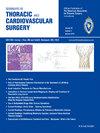Improving Repair Durability in Severe Ischemic Mitral Regurgitation: Revisiting Patient Selection and Adjunctive Repair Techniques
IF 2.5
3区 医学
Q2 CARDIAC & CARDIOVASCULAR SYSTEMS
Seminars in Thoracic and Cardiovascular Surgery
Pub Date : 2025-06-27
DOI:10.1053/j.semtcvs.2025.04.009
引用次数: 0
Abstract
Ischemic mitral regurgitation (IMR) is a complex heterogeneous complication following myocardial infarction, characterized by left ventricular (LV) remodeling and subsequent valvular distortion. The primary mechanisms include papillary muscle displacement, mitral leaflet tethering, and impaired coaptation following annular dilatation. IMR is associated with poor prognosis and an increased incidence of heart failure. We reviewed studies on the surgical management of IMR published over the past 2 decades. While mitral valve repair has been favored for its advantages of low perioperative mortality and LV function preservation, high rates of mitral regurgitation recurrence limit its long-term durability. Regarding repair strategy, apart from restrictive mitral annuloplasty, the adjunctive techniques of papillary muscle relocation, papillary muscle approximation, and leaflet augmentation have been proposed. These approaches aim to address LV remodeling and improve leaflet coaptation by mitigating subvalvular tethering. Moreover, the application of true-size annuloplasty and “functional repair” strategies in IMR patients with enlarged LV emphasizes the need to tailor interventions to patients’ LV dimensions and dynamic changes. Accumulating clinical evidence highlights the importance of meticulous patient selection and functional mitral valve repair, which remains a promising approach contingent on enhanced understanding of IMR’s pathophysiology and its interplay with LV remodeling. The current review summarizes our patient selection criteria and indications for surgical repair (including the use of adjunctive techniques of subvalvular intervention) or mitral valve replacement.
提高严重缺血性二尖瓣返流的修复耐久性:重新审视患者选择和辅助修复技术。
缺血性二尖瓣反流(IMR)是心肌梗死后的一种复杂的异质并发症,其特征是左室(LV)重构和随后的瓣膜畸变。其主要机制包括乳头肌移位、二尖瓣小叶栓系以及环扩张后的适应功能受损。IMR与预后不良和心力衰竭发生率增加有关。我们回顾了过去二十年来发表的关于IMR手术治疗的研究。二尖瓣修复术因其低围手术期死亡率和保留左室功能的优势而受到青睐,但二尖瓣返流的高复发率限制了其长期的持久性。关于修复策略,除了限制性二尖瓣环成形术外,还提出了乳头肌移位、乳头肌逼近和小叶增大的辅助技术。这些方法旨在通过减轻瓣下栓系来解决左室重塑和改善小叶适应。此外,在LV扩大的IMR患者中应用真实尺寸的环成形术和“功能修复”策略,强调需要根据患者的LV尺寸和动态变化量身定制干预措施。越来越多的临床证据强调了细致的患者选择和功能二尖瓣修复的重要性,这仍然是一种有前途的方法,取决于对IMR病理生理学及其与左室重塑的相互作用的进一步了解。目前的综述总结了我们的患者选择标准和手术修复(包括使用瓣下介入辅助技术)或二尖瓣置换术的适应症。
本文章由计算机程序翻译,如有差异,请以英文原文为准。
求助全文
约1分钟内获得全文
求助全文
来源期刊

Seminars in Thoracic and Cardiovascular Surgery
Medicine-Pulmonary and Respiratory Medicine
CiteScore
5.80
自引率
0.00%
发文量
324
审稿时长
12 days
期刊介绍:
Seminars in Thoracic and Cardiovascular Surgery is devoted to providing a forum for cardiothoracic surgeons to disseminate and discuss important new information and to gain insight into unresolved areas of question in the specialty. Each issue presents readers with a selection of original peer-reviewed articles accompanied by editorial commentary from specialists in the field. In addition, readers are offered valuable invited articles: State of Views editorials and Current Readings highlighting the latest contributions on central or controversial issues. Another prized feature is expert roundtable discussions in which experts debate critical questions for cardiothoracic treatment and care. Seminars is an invitation-only publication that receives original submissions transferred ONLY from its sister publication, The Journal of Thoracic and Cardiovascular Surgery. As we continue to expand the reach of the Journal, we will explore the possibility of accepting unsolicited manuscripts in the future.
 求助内容:
求助内容: 应助结果提醒方式:
应助结果提醒方式:


